Abstract
A "caged" analogue of the alpha-adrenergic receptor agonist phenylephrine (PE) was prepared by exploiting the 2-nitrobenzyl protecting group and using a synthetic procedure developed to permit preferential derivatization at the amino group. On isolated adult rat mesenteric arterioles, caged-PE had no measurable effects at concentrations up to 100 microM; 0.5-ms light flashes in the presence of caged-PE, however, produced marked and dose-dependent vasoconstriction. Flash-induced vasoconstrictions were blocked by the alpha-receptor antagonist phentolamine and were unaffected by the beta-receptor antagonist propranolol, indicating that the light-induced responses reflect the selective activation of alpha-adrenergic receptors. After a single flash, a large transient decrease in vessel diameter was recorded, and in most vessels, this was followed by a smaller, sustained constriction. The sustained component of the contraction was selectively eliminated when Ca2+ was removed from the bath, which suggests that different mechanisms underlie the transient and the sustained responses to PE. The responses to single flashes of varying intensities occurred with a mean latency of 460 ms, which is consistent with the intermediacy of several steps between alpha-receptor activation and contraction. We anticipate that it will be possible to extend this approach to develop caged analogues of other neurotransmitters for mechanistic and kinetic studies.
Full text
PDF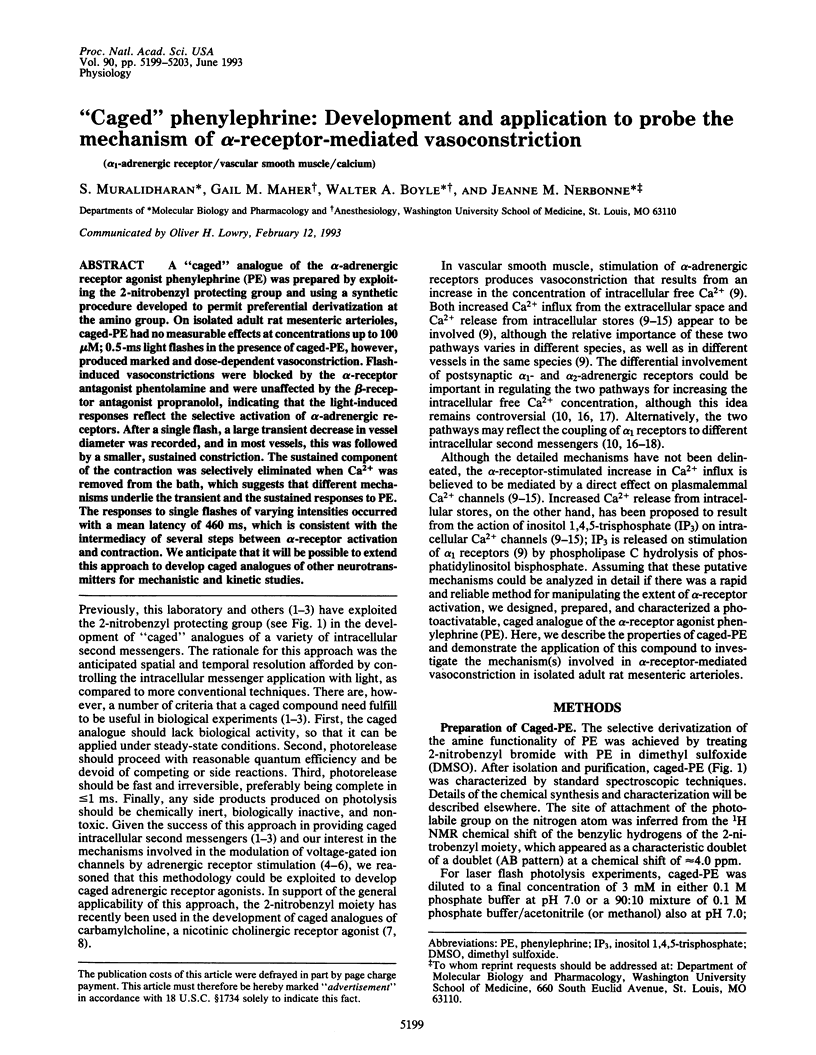
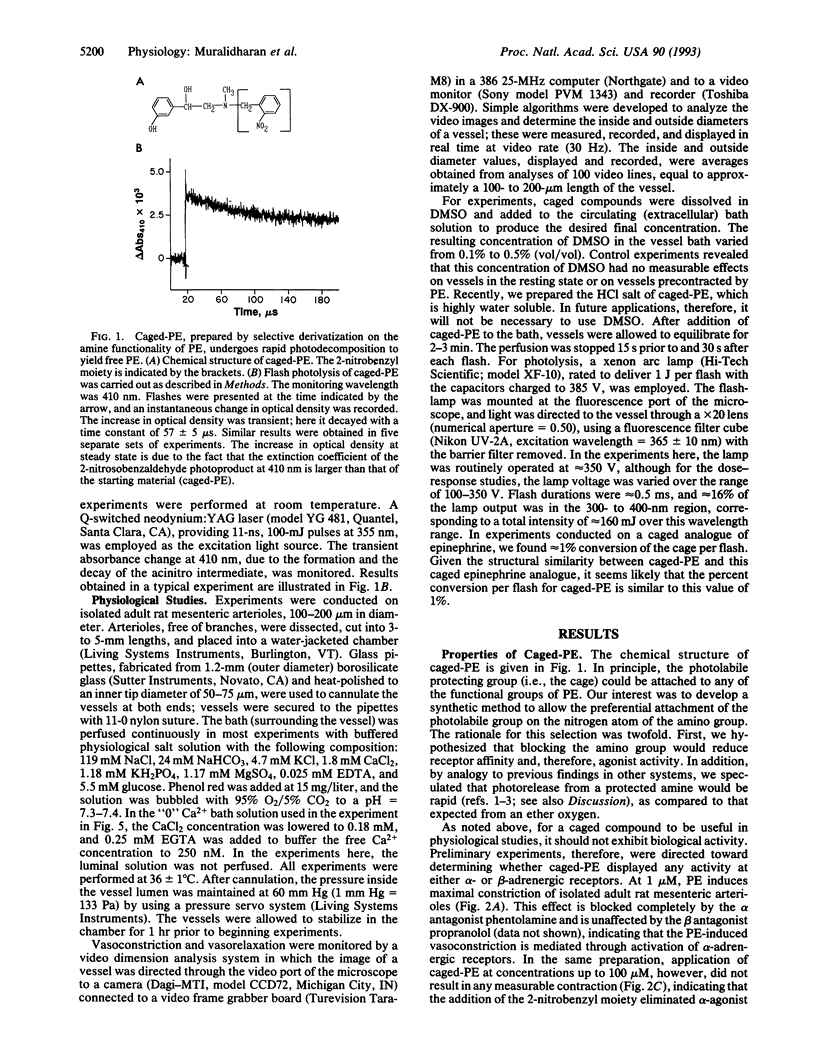
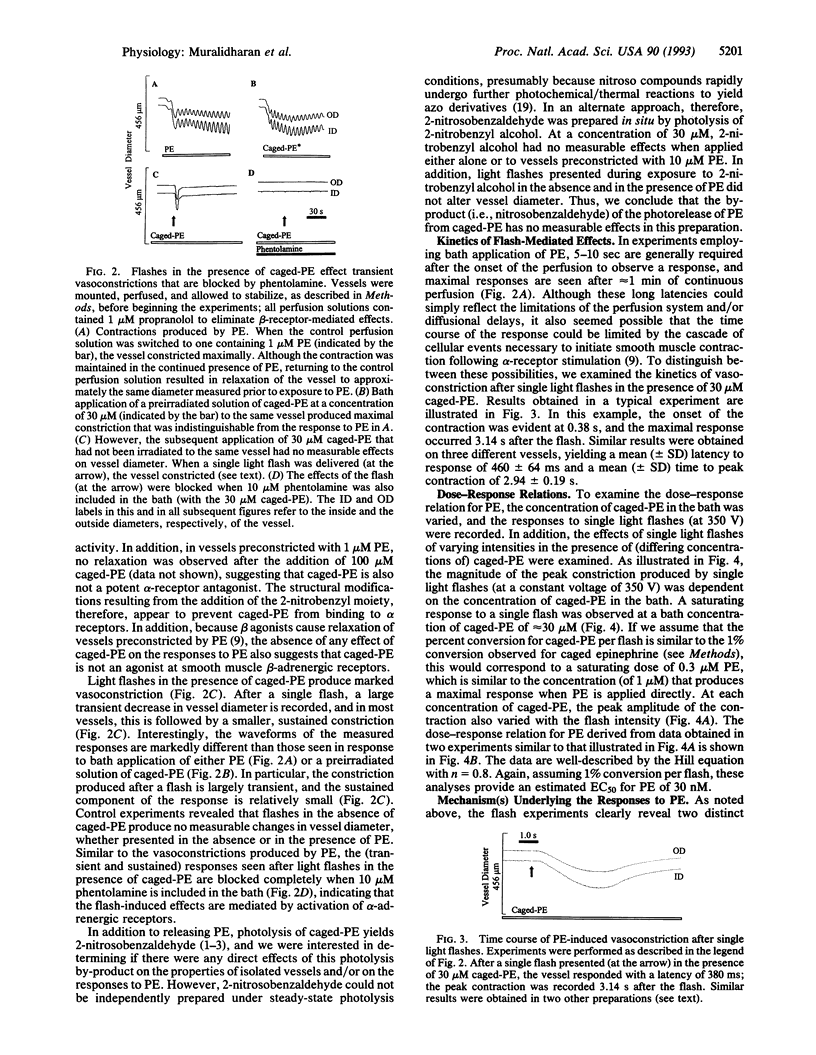
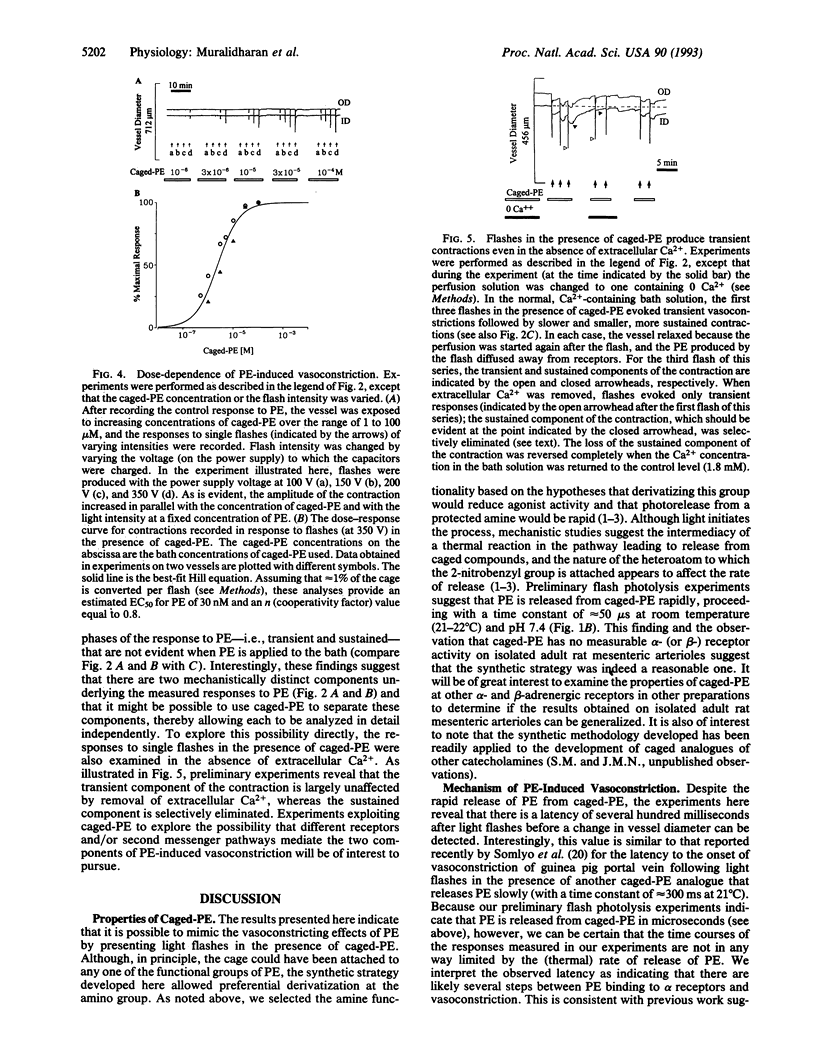
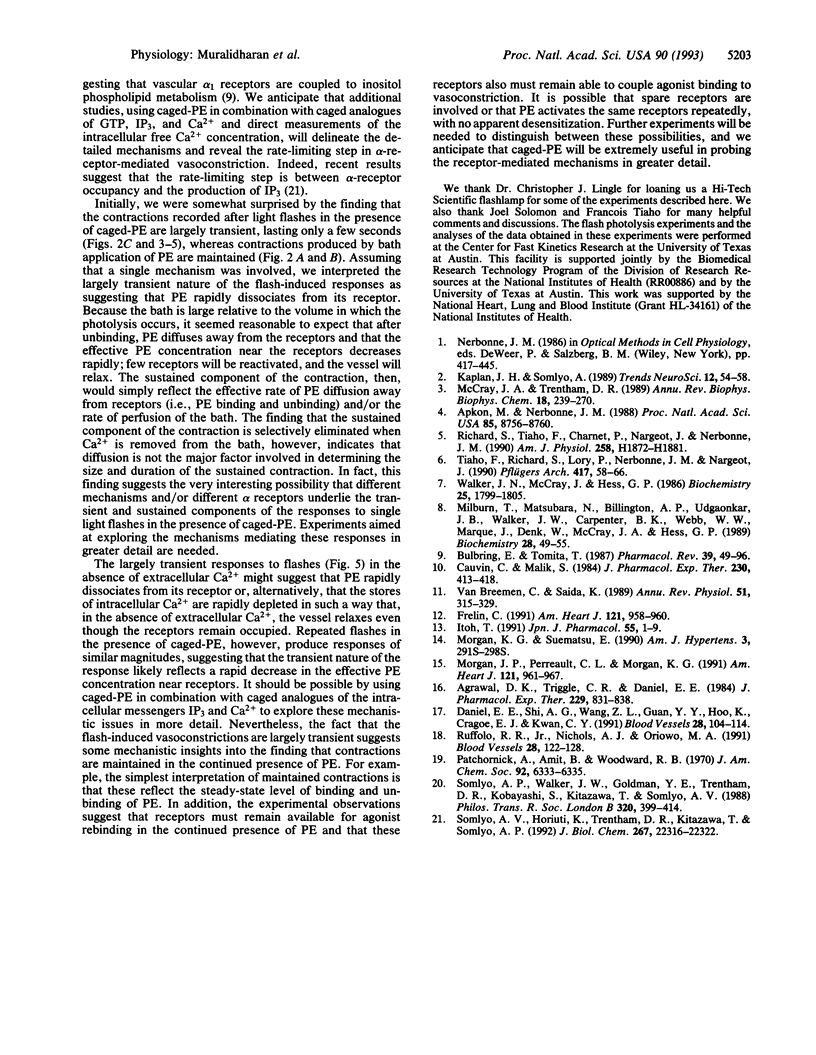
Selected References
These references are in PubMed. This may not be the complete list of references from this article.
- Agrawal D. K., Triggle C. R., Daniel E. E. Pharmacological characterization of the postsynaptic alpha adrenoceptors in vascular smooth muscle from canine and rat mesenteric vascular beds. J Pharmacol Exp Ther. 1984 Jun;229(3):831–838. [PubMed] [Google Scholar]
- Apkon M., Nerbonne J. M. Alpha 1-adrenergic agonists selectively suppress voltage-dependent K+ current in rat ventricular myocytes. Proc Natl Acad Sci U S A. 1988 Nov;85(22):8756–8760. doi: 10.1073/pnas.85.22.8756. [DOI] [PMC free article] [PubMed] [Google Scholar]
- Bülbring E., Tomita T. Catecholamine action on smooth muscle. Pharmacol Rev. 1987 Mar;39(1):49–96. [PubMed] [Google Scholar]
- Cauvin C., Malik S. Induction of Ca++ influx and intracellular Ca++ release in isolated rat aorta and mesenteric resistance vessels by norepinephrine activation of alpha-1 receptors. J Pharmacol Exp Ther. 1984 Aug;230(2):413–418. [PubMed] [Google Scholar]
- Daniel E. E., Shi A. G., Wang Z. L., Guan Y. Y., Hoo K., Cragoe E. J., Kwan C. Y. Alpha-adrenoceptors in vascular smooth muscle: all is not well. Blood Vessels. 1991;28(1-3):104–114. doi: 10.1159/000158849. [DOI] [PubMed] [Google Scholar]
- Frelin C. Mechanisms of vasoconstriction. Am Heart J. 1991 Mar;121(3 Pt 1):958–960. doi: 10.1016/0002-8703(91)90226-8. [DOI] [PubMed] [Google Scholar]
- Itoh T. Pharmacomechanical coupling in vascular smooth muscle cells--an overview. Jpn J Pharmacol. 1991 Jan;55(1):1–9. doi: 10.1254/jjp.55.1. [DOI] [PubMed] [Google Scholar]
- Kaplan J. H., Somlyo A. P. Flash photolysis of caged compounds: new tools for cellular physiology. Trends Neurosci. 1989 Feb;12(2):54–59. doi: 10.1016/0166-2236(89)90136-7. [DOI] [PubMed] [Google Scholar]
- McCray J. A., Trentham D. R. Properties and uses of photoreactive caged compounds. Annu Rev Biophys Biophys Chem. 1989;18:239–270. doi: 10.1146/annurev.bb.18.060189.001323. [DOI] [PubMed] [Google Scholar]
- Milburn T., Matsubara N., Billington A. P., Udgaonkar J. B., Walker J. W., Carpenter B. K., Webb W. W., Marque J., Denk W., McCray J. A. Synthesis, photochemistry, and biological activity of a caged photolabile acetylcholine receptor ligand. Biochemistry. 1989 Jan 10;28(1):49–55. doi: 10.1021/bi00427a008. [DOI] [PubMed] [Google Scholar]
- Morgan J. P., Perreault C. L., Morgan K. G. The cellular basis of contraction and relaxation in cardiac and vascular smooth muscle. Am Heart J. 1991 Mar;121(3 Pt 1):961–968. doi: 10.1016/0002-8703(91)90227-9. [DOI] [PubMed] [Google Scholar]
- Morgan K. G., Suematsu E. Effects of calcium on vascular smooth muscle tone. Am J Hypertens. 1990 Dec;3(12 Pt 2):291S–298S. [PubMed] [Google Scholar]
- Richard S., Tiaho F., Charnet P., Nargeot J., Nerbonne J. M. Two pathways for Ca2+ channel gating differentially modulated by physiological stimuli. Am J Physiol. 1990 Jun;258(6 Pt 2):H1872–H1881. doi: 10.1152/ajpheart.1990.258.6.H1872. [DOI] [PubMed] [Google Scholar]
- Ruffolo R. R., Jr, Nichols A. J., Oriowo M. A. Interaction of vascular alpha-1 adrenoceptors with multiple signal transduction pathways. Blood Vessels. 1991;28(1-3):122–128. doi: 10.1159/000158851. [DOI] [PubMed] [Google Scholar]
- Somlyo A. P., Walker J. W., Goldman Y. E., Trentham D. R., Kobayashi S., Kitazawa T., Somlyo A. V. Inositol trisphosphate, calcium and muscle contraction. Philos Trans R Soc Lond B Biol Sci. 1988 Jul 26;320(1199):399–414. doi: 10.1098/rstb.1988.0084. [DOI] [PubMed] [Google Scholar]
- Somlyo A. V., Horiuti K., Trentham D. R., Kitazawa T., Somlyo A. P. Kinetics of Ca2+ release and contraction induced by photolysis of caged D-myo-inositol 1,4,5-trisphosphate in smooth muscle. The effects of heparin, procaine, and adenine nucleotides. J Biol Chem. 1992 Nov 5;267(31):22316–22322. [PubMed] [Google Scholar]
- Tiaho F., Richard S., Lory P., Nerbonne J. M., Nargeot J. Cyclic-AMP-dependent phosphorylation modulates the stereospecific activation of cardiac Ca channels by Bay K 8644. Pflugers Arch. 1990 Sep;417(1):58–66. doi: 10.1007/BF00370769. [DOI] [PubMed] [Google Scholar]
- Walker J. W., McCray J. A., Hess G. P. Photolabile protecting groups for an acetylcholine receptor ligand. Synthesis and photochemistry of a new class of o-nitrobenzyl derivatives and their effects on receptor function. Biochemistry. 1986 Apr 8;25(7):1799–1805. doi: 10.1021/bi00355a052. [DOI] [PubMed] [Google Scholar]
- van Breemen C., Saida K. Cellular mechanisms regulating [Ca2+]i smooth muscle. Annu Rev Physiol. 1989;51:315–329. doi: 10.1146/annurev.ph.51.030189.001531. [DOI] [PubMed] [Google Scholar]


